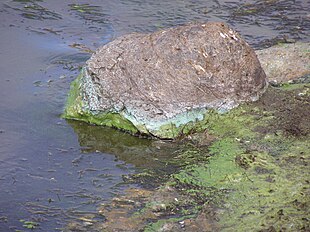
Cyanotoxins are toxins produced by cyanobacteria (also known as blue-green algae). Cyanobacteria are found almost everywhere, but particularly in lakes and in the ocean where, under high concentration of phosphorus conditions, they reproduce exponentially to form blooms. Blooming cyanobacteria can produce cyanotoxins in such concentrations that they can poison and even kill animals and humans. Cyanotoxins can also accumulate in other animals such as fish and shellfish, and cause poisonings such as shellfish poisoning.
Some of the most powerful natural poisons known are cyanotoxins. They include potent neurotoxins, hepatotoxins, cytotoxins, and endotoxins. The cyano in the term cyanobacteria refers to its colour, not to its relation to cyanides, though cyanobacteria can catabolize hydrogen cyanide during nitrogen fixation.[1]
Exposure to cyanobacteria can result in gastro-intestinal and hayfever symptoms or pruritic skin rashes.[2] Exposure to the cyanobacteria neurotoxin BMAA may be an environmental cause of neurodegenerative diseases such as amyotrophic lateral sclerosis (ALS), Parkinson's disease, and Alzheimer's disease.[3] There is also an interest in the military potential of biological neurotoxins such as cyanotoxins, which "have gained increasing significance as potential candidates for weaponization."[4]
The first published report that blue-green algae or cyanobacteria could have lethal effects appeared in Nature in 1878. George Francis described the algal bloom he observed in the estuary of the Murray River in Australia, as "a thick scum like green oil paint, some two to six inches thick." Wildlife which drank the water died rapidly and terribly.[5] Most reported incidents of poisoning by microalgal toxins have occurred in freshwater environments, and they are becoming more common and widespread. For example, thousands of ducks and geese died drinking contaminated water in the midwestern United States.[6] In 2010, for the first time, marine mammals were reported to have died from ingesting cyanotoxins.[7]
- ^ Panou, Manthos; Gkelis, Spyros (2020-01-06), Cyano-assassins: Widespread cyanogenic production from cyanobacteria, doi:10.1101/2020.01.04.894782
- ^ Stewart I, Webb PM, Schluter PJ, Shaw GR (2006). "Recreational and occupational field exposure to freshwater cyanobacteria – a review of anecdotal and case reports, epidemiological studies and the challenges for epidemiologic assessment". Environmental Health. 5 (1): 6. doi:10.1186/1476-069X-5-6. PMC 1513208. PMID 16563159.
- ^ Holtcamp, W. (2012). "The emerging science of BMAA: do cyanobacteria contribute to neurodegenerative disease?". Environmental Health Perspectives. 120 (3): a110–a116. doi:10.1289/ehp.120-a110. PMC 3295368. PMID 22382274.
- ^ Dixit A, Dhaked RK, Alam SI, Singh L (2005). "Military potential of biological neurotoxins". Toxin Reviews. 24 (2): 175–207. doi:10.1081/TXR-200057850. S2CID 85651107.
- ^ Francis G (1878). "Poisonous Australian Lake". Nature. 18 (444): 11–12. Bibcode:1878Natur..18...11F. doi:10.1038/018011d0. S2CID 46276288.
- ^ Anatoxin Neil Edwards, University of Sussex at Brighton. Updated 1 September 1999. Retrieved 19 January 2011.
- ^ Cite error: The named reference
Milleretalwas invoked but never defined (see the help page).